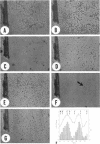Abstract
Hampar, Berge (National Institute of Dental Research, Bethesda, Md.), and Mary Lou Copeland. Persistent herpes simplex virus infection in vitro with cycles of cell destruction and regrowth. J. Bacteriol. 90:205–212. 1965.—The susceptibility of two Chinese hamster cell lines to herpes simplex virus (HSV) was studied from the time of their initiation through successive subcultures. The cells' susceptibility to the cytocidal effects of HSV decreased as the number of cell passages increased. During the early cell passages, the decrease in cell susceptibility to HSV was characterized by an increased time after infection for complete cell destruction to occur, with a concomitant increase in the period when virus could be recovered from supernatant fluids. This was followed by a number of cell passages during which persistent HSV infections were established. The persistent infections were characterized by (i) cycles of virus synthesis and cell destruction followed by regrowth of the cells, (ii) initiation and maintenance under conditions optimal for cell growth in the absence of antibody, (iii) the cells' ability to be passaged while still maintaining their cycling patterns, (iv) a relationship between virus synthesis and cell proliferation, and (v) inability of long-term treatment with antibody to “cure” the persistent infections. The unique characteristics of this HSV infection were compared with other persistent in vitro viral infections.
Full text
PDF







Images in this article
Selected References
These references are in PubMed. This may not be the complete list of references from this article.
- ASHE W. K., SCHERP H. W. ANTIGENIC ANALYSIS OF HERPES SIMPLEX VIRUS BY NEUTRALIZATION KINETICS. J Immunol. 1963 Nov;91:658–665. [PubMed] [Google Scholar]
- BANG F. B., GEY G. O., FOARD M., MINNEGAN D. Comparative susceptibility of cultured cell strains to the virus of eastern equine encephalomyelitis. Bull Johns Hopkins Hosp. 1952 Dec;91(6):427–461. [PubMed] [Google Scholar]
- COLEMAN V., JAWETZ E. A persistent herpes simplex infection in antibody-free cell culture. Virology. 1961 Mar;13:375–377. doi: 10.1016/0042-6822(61)90162-3. [DOI] [PubMed] [Google Scholar]
- FORD D. K., BOGUSZEWSKI C., AUERSPERG N. Chinese-hamster cell strains in vitro:spontaneous chromosome changes and latent polyoma-virus infection. J Natl Cancer Inst. 1961 Mar;26:691–706. [PubMed] [Google Scholar]
- GIL FERNANDEZ C. Persistence of herpes simplex virus in HeLa cells. Nature. 1960 Jan 23;185:268–268. doi: 10.1038/185268a0. [DOI] [PubMed] [Google Scholar]
- GINSBERG H. S. The significance of the viral carrier state in tissue culture systems. Prog Med Virol. 1958;1:36–58. [PubMed] [Google Scholar]
- GLASGOW L. A., HABEL K. Role of polyoma virus and interferon in a herpes simplex virus infection in vitro. Virology. 1963 Mar;19:328–339. doi: 10.1016/0042-6822(63)90072-2. [DOI] [PubMed] [Google Scholar]
- GLASGOW L. A., HABEL K. The role of interferon in vaccinia virus infection of mouse embryo tissue culture. J Exp Med. 1962 Mar 1;115:503–512. doi: 10.1084/jem.115.3.503. [DOI] [PMC free article] [PubMed] [Google Scholar]
- GRAY A., TOKUMARU T., SCOTT T. F. M. Different cytopathogenic effects observed in HeLa cells infected with herpes simplex virus. Arch Gesamte Virusforsch. 1958;8(1):59–76. doi: 10.1007/BF01242313. [DOI] [PubMed] [Google Scholar]
- HAMPAR B., ELLISON S. A. Cellular alterations in the MCH line of Chinese hamster cells following infection with herpes simplex virus. Proc Natl Acad Sci U S A. 1963 Apr;49:474–480. doi: 10.1073/pnas.49.4.474. [DOI] [PMC free article] [PubMed] [Google Scholar]
- HAMPAR B., ELLISON S. A. Chromosomal aberrations induced by an animal virus. Nature. 1961 Oct 14;192:145–147. doi: 10.1038/192145a0. [DOI] [PubMed] [Google Scholar]
- HAMPAR B., ELLISON S. A. INFECTION OF MCH CHINESE HAMSTER CELLS WITH HERPES SIMPLEX VIRUS: RELATION OF CELL KILLING TO TIME OF DIVISION. Virology. 1964 Dec;24:654–659. doi: 10.1016/0042-6822(64)90220-x. [DOI] [PubMed] [Google Scholar]
- HENLE W. INTERFERENCE AND INTERFERON IN PERSISTENT VIRAL INFECTIONS OF CELL CULTURES. J Immunol. 1963 Aug;91:145–150. [PubMed] [Google Scholar]
- HINZE H. C., WALKER D. L. Variation of herpes simplex virus in persistently infected tissue cultures. J Bacteriol. 1961 Oct;82:498–504. doi: 10.1128/jb.82.4.498-504.1961. [DOI] [PMC free article] [PubMed] [Google Scholar]
- MAZZONE H. M., YERGANIAN G. Gross and chromosomal cytology of virus infected Chinese hamster cells. Exp Cell Res. 1963 May;30:591–592. doi: 10.1016/0014-4827(63)90336-7. [DOI] [PubMed] [Google Scholar]
- RAPP F., HSU T. C. VIRUSES AND MAMMALIAN CHROMOSOMES. IV. REPLICATION OF HERPES SIMPLEX VIRUS IN DIPLOID CHINESE HAMSTER CELLS. Virology. 1965 Mar;25:401–411. doi: 10.1016/0042-6822(65)90061-9. [DOI] [PubMed] [Google Scholar]
- SCOTT T. F., CORIELL L. L., BLANK H., GRAY A. The growth curve of the virus of herpes simplex on the choriollantoic membrane of the embryonated hen's egg. J Immunol. 1953 Sep;71(3):134–144. [PubMed] [Google Scholar]
- STICH H. F., HSU T. C., RAPP F. VIRUSES AND MAMMALIAN CHROMOSOMES. I. LOCALIZATION OF CHROMOSOME ABERRATIONS AFTER INFECTION WITH HERPES SIMPLEX VIRUS. Virology. 1964 Apr;22:439–445. doi: 10.1016/0042-6822(64)90064-9. [DOI] [PubMed] [Google Scholar]
- STOKER M. G. Mode of intercellular transfer of herpes virus. Nature. 1958 Nov 29;182(4648):1525–1526. doi: 10.1038/1821525a0. [DOI] [PubMed] [Google Scholar]
- SZANTO J. COURSE OF PERSISTENT INFECTION OF HELA AND DETROIT 6 CELLS WITH HERPES SIMPLEX VIRUS. Acta Virol. 1963 Sep;7:385–392. [PubMed] [Google Scholar]
- WHEELER C. E., CANBY C. M. Influence of specific antibody on herpes simplex infections in tissue culture. AMA Arch Derm. 1959 Jan;79(1):86–95. doi: 10.1001/archderm.1959.01560130088010. [DOI] [PubMed] [Google Scholar]
- WHEELER C. E. Further studies on the effect of neutralizing antibody upon the course of herpes simplex infections in tissue culture. J Immunol. 1960 Apr;84:394–403. [PubMed] [Google Scholar]



